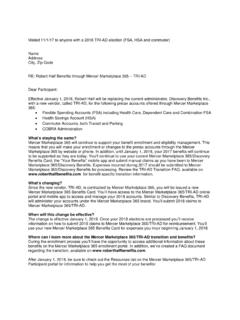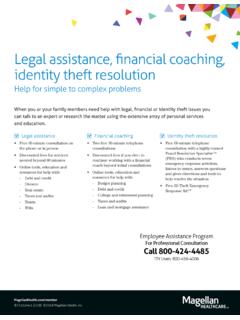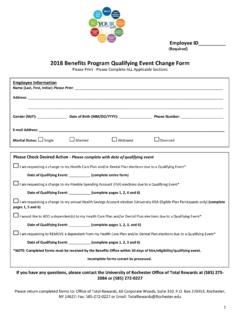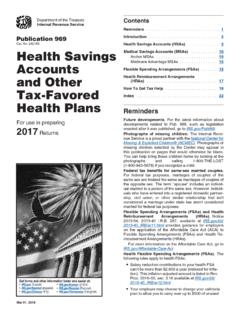Transcription of HOW THE 2018 TAX-ADVANTAGED ACCOUNTS …
1 Did you know you can save money by contributing to a TAX-ADVANTAGED account ? You can set aside pre-tax money through payroll deductions to pay for eligible expenses, which can reduce your taxable income and may result in you paying less in taxes. HEALTH CARE EXPENSESR obert Half offers three types of TAX-ADVANTAGED ACCOUNTS for health care expenses. 1. Health Care Flexible spending account (FSA) The Health Care FSA is for eligible health care expenses such as out-of-pocket medical, dental, vision and prescription drug expenses, such as copays, coinsurance, deductibles, glasses and contact lenses, orthodontia treatment, and Lasik Keep in mind, this FSA has a use-it-or-lose-it rule and contributions won t roll over to the next plan Combination Health Care Flexible spending account (FSA)If you re enrolled in the $1,500 or $2,500 Deductible Plan, the Combination Health Care FSA allows you to use your pre-tax FSA funds for eligible dental and vision expenses in addition to medical expenses once you meet the IRS deductible limit.
2 The IRS deductible limits are: Individual coverage: $1,350 Family coverage: $2,700 Keep in mind, this FSA has a use-it-or-lose-it rule and contributions won t roll over to the next plan Combination FSA is only available to those enrolled in the $1,500 Deductible and $2,500 Deductible Plans, and who contribute to a Health savings account (HSA).3. Health savings account (HSA) The HSA can be used to pay for out-of-pocket medical, prescription drug, dental and vision expenses, including copays, coinsurance and deductibles. In 2018 , when you make contributions to your HSA, you ll also receive matching contributions from Robert Half (up to the maximum matching contribution amount).2 This helps your HSA savings grow over : To contribute to an HSA through Robert Half, you must be enrolled in either the $1,500 Deductible or the $2,500 Deductible Plan, and, you cannot be enrolled in Medicare Part A or Part B.
3 1 Find a full list of eligible Health Care FSA expenses at Robert Half matching contributions are not available to Salaried Professionals or part-time Robert Half !The medical plan option you choose determines what health care account or ACCOUNTS you can use: If you enroll in the $400 Deductible or the $900 Deductible Plan (or no plan), you can contribute to a Health Care FSA. If you enroll in the $1,500 Deductible or the $2,500 Deductible Plan, you have several options: 1. Contribute to a Health savings account (HSA) and a Combination Health Care FSA 2. Contribute to an HSA only3. Contribute to a Health Care FSA only Why Contribute to Both a Combination FSA and an HSA?If you participate in the $1,500 Deductible Plan or the $2,500 Deductible Plan, you can maximize your tax savings by using a Combination Health Care FSA along with your HSA, especially if you expect significant dental or vision expenses in 2018 .
4 For example, if you plan to have major expenses for things like crowns, dental implants or LASIK surgery, consider using the Combination Health Care FSA first to pay for those expenses. DEPENDENT CARE EXPENSESR obert Half also offers a TAX-ADVANTAGED account to help pay for eligible dependent care expenses, including day care, preschool and after-school care for a dependent child under age 13 or for a tax dependent who is physically or mentally incapable of self-care. See the next page for a summary comparison of the TAX-ADVANTAGED ACCOUNTS . HOW THE 2018 TAX-ADVANTAGED ACCOUNTS WORKMYBENEFITSU pdated May 10, 2018 COMPARISON OF TAX-ADVANTAGED ACCOUNTSH ealth savings account (HSA)Flexible spending ACCOUNTS (FSAs)Health Care FSAC ombination Health Care FSAD ependent Care Reimbursement AccountWho is eligible?
5 Employees who enroll in the $1,500 Deductible Plan or the $2,500 Deductible Plan Employees who don t enroll in a high-deductible medical plan Employees who enroll in $1,500 Deductible Plan or the $2,500 Deductible Plan and choose not to contribute to an HSAE mployees who: Enroll in $1,500 Deductible Plan or the $2,500 Deductible Plan AND Elect to contribute to an HSAAll benefits-eligible employees How much can I contribute in 2018 ? $3,450 for single coverage $6,900 for family coverageIncludes both your contributions and any contributions from Robert HalfAge 55 or older? Contribute an additional $1,000 per year$2,6504$2,6504 $5,000, if you are single, or married and file joint tax returns4 $2,500, if you are married and file separate tax returns4 Will Robert Half contribute?
6 Yes; for 2018 , Robert Half matches $ of every $1 you contribute, up to certain limits1 NoNoNoWhat are eligible expenses?Medical, prescription drug, dental and vision expenses not paid by your insurance2 Medical, prescription drug, dental and vision expenses not paid by your insurance2 Dental and vision expenses only until you meet the IRS deductible limit of: $1,350 for individual coverage $2,700 for family coverage Once you meet the IRS deductible limit and submit the appropriate verification form for approval, funds can also be used for medical care, preschool, after-school care for a dependent child under age 13 or for a tax dependent who is physically or mentally incapable of self-care3 What funds are available?
7 Only the money in your accountYour full contribution amount at the beginning of the yearYour full contribution amount at the beginning of the yearOnly the money in your accountHow do I pay eligible expenses?Use your Mercer Marketplace 365/TRI-AD Benefits Card or file a claim for reimbursementUse your Mercer Marketplace 365/TRI-AD Benefits Card or file a claim for reimbursementFor dental and vision expenses, use your Mercer Marketplace 365/TRI-AD Benefits Card (the same one that you use for your HSA expenses), or you can file claims directly for reimbursement. For medical expenses (once eligible), claims must be submitted manually. Use your Mercer Marketplace 365/TRI-AD Benefits Card or file a claim for reimbursementWhat is the deadline for reimbursement?
8 None For expenses incurred January 1 December 31, 2018 , you may submit claims for eligible expenses until March 31, 2019 What happens to unused contributions?Unused funds roll over for future health care expensesUnused funds are forfeited at the end of the year go to to help calculate your expensesCan I change my contributions at any time during the year?Yes, at any time; subject to administrative processing timeOnly within 30 days of a qualified life event, such as marriage or birthWhere can I go with questions? For questions about 2018 claims, reimbursement and eligible expenses, contact TRI-AD: questions about benefit decisions, enrollment or eligibility questions, contact the Mercer Marketplace 365 at Robert Half matching contributions are not available to Salaried Professionals or part-time Robert Half employees.
9 2 See IRS Publication 502 at for a complete listing of eligible health care See IRS Publication 503 at for a complete listing of eligible child and dependent care Note to Highly Compensated Employees: If you are a Highly Compensated Employee (as defined by the IRS), it is possible your FSA contributions may be limited prior to the beginning of the plan year or suspended during the plan year depending on the outcome of certain nondiscrimination tests imposed on FSAs by the IRS. If a limitation or suspension becomes necessary, you will be notified in writing before it there is any discrepancy between the information presented here and the applicable official plan document, the official plan document will govern how your benefits are determined and administered.
10 Robert Half reserves the right to terminate, suspend, withdraw or modify the benefits described in this document, in whole or in part, at any time. 2017 Robert Half International Inc. An Equal Opportunity Employer M/F/ May 10, 2018







